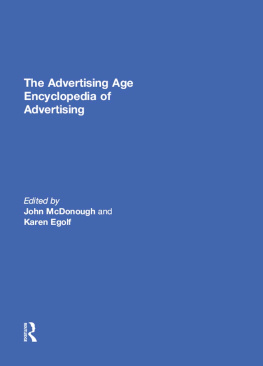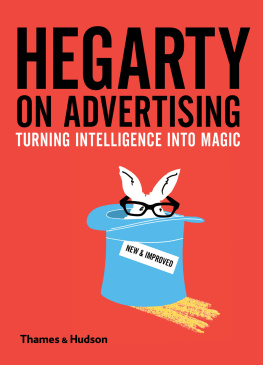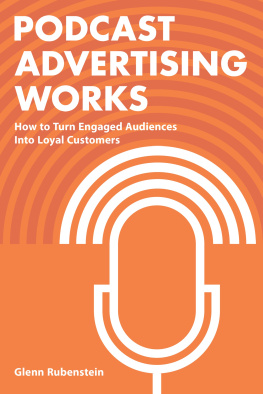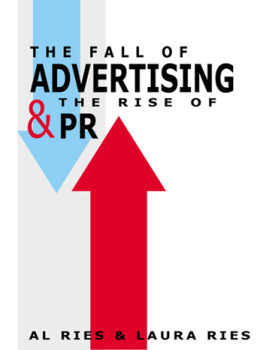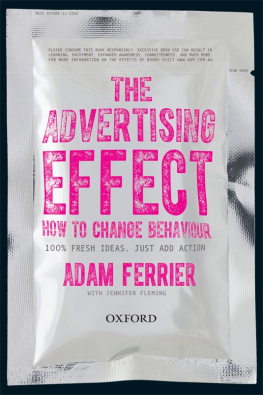
The Advertising Age
Encyclopedia of Advertising
The Advertising Age
Encyclopedia of Advertising
AZ
Editors
JOHN MCDONOUGH AND THE MUSEUM OF
BROADCAST COMMUNICATIONS
KAREN EGOLF, ADVERTISING AGE
Illustration Editor
JACQUELINE V. REID
HARTMAN CENTER FOR SALES, ADVERTISING, AND
MARKETING HISTORY OF DUKE UNIVERSITY

Copyright 2002
FITZROY DEARBORN PUBLISHERS
All rights reserved including the right of reproduction in whole or in part in any form. For information, write to:
FITZROY DEARBORN PUBLISHERS
919 North Michigan Avenue, Suite 760
Chicago, IL 60611
USA
or
FITZROY DEARBORN PUBLISHERS
310 Regent Street London W1R 5AJ
UK
British Library and Library of Congress Cataloguing in Publication Data are available.
ISBN 1-57958-172-2
First published in the USA and UK 2002
Typeset by Andrea Rosenberg
Printed by Edwards Brothers, Ann Arbor, Michigan
Cover design by Peter Aristedes, Chicago Advertising and Design, Chicago, Illinois
Front cover illustrations: Duke Cigarettes (American Tobacco Company). J. Walter Thompson, courtesy of the J. Walter Thompson Company. Citron, courtesy of Citron, Citron Communication. Lux Toilet Soap, courtesy of Unilever. Leo Burnett, courtesy of Leo Burnett Company, Inc. Coca-Cola, courtesy of The Coca-Cola Company. Sears, Roebuck & Company, reprinted by arrangement with Sears, Roebuck and Co. and protected under copyright; no duplication is permitted. Green Giant Peas and Niblets Whole Kernel Corn, courtesy of The Pillsbury Company. Alka-Seltzer, courtesy of Bayer Corporation.
Back cover illustrations: Cadburys Cocoa, reprinted with permission of Cadbury Schweppes plc. U.S. Army (I want YOU). G.D. Crain, Jr., courtesy of Crain Communications, Inc. William Bernbach, courtesy of DDB. Broadway and 47th Street, New York City, ca. 1940. Michelin, courtesy of Michelin North America, Inc. Clio Award, courtesy of the Clio Awards. Planters, courtesy of Kraft Foods Holdlings, Inc.
CONTENTS
From John McDonough
An encyclopedia is typically an instrument of convenience, not scholarship. It offers an overview of otherwise widely available information assembled in a volume or two for handy and expedient access. This encyclopedia is, to a considerable degree, the exception. Unlike the well-documented histories of many other fields, much of advertisings past remains buried, reported only in rare contemporary press accounts and other primary sources. Even trained researchers have found this material difficult to locate.
The histories written about major corporations and marketers are typically silent on the specific role of advertising and ad agencies in their growth. There have been periodic general overviews of developments in advertising, most recently the excellent revised edition of The Mirror Makers by Stephen Fox. But not even that superb account could document the parade of important advertising agencies that were established, prospered, and then disappeared during the past 75 years or so. We hope these volumes will shed new light on their contributions to the profession.
There are several reasons why the agency side of the advertising businessas well as the advertising side of marketinghas been neglected. Anyone reading Advertising Age, the principal industry trade publication since 1930, will be struck by the extent to which the weekly coverage focuses on advertisers rather than ad agencies. Historically, the agencies, with a few exceptions, have preferredor were obligedto remain in the background. Like law firms, they regarded their customers as clients and were privy to much confidential information that required discretion. Also like law firms, they were agents, even alter egos, of their employers and resisted the scrutiny of outsiders and the media. While the actual advertising created by an agency in the name of an advertiser may have been aggressively public, the creative process itself was inclined to be intensely private.
Moreover, prior to 1962 agencies were, with one minor exception, privately held and under no obligation to reveal billings, income, or other financial data. Their role was to bring attention to their clients, not themselves. It was not until 1944 that Advertising Age undertook to publish annual rankings of agencies, first by billings and later by gross income and other measures. But the early rankings were in many cases based on estimates, not on hard data made available by agencies. All these practices contributed to the relatively low profile maintained by ad agencies, a barrier of secrecy breached only when a few individual agencies placed house ads in the trade pressand most prominently in Fortune, a magazine so expensive in the 1930S ($1 per issue) that agencies could be sure that no one below the level of senior management would ever see their advertising.
Yet another reason business historians have neglected agencies is their brittle, personality driven nature. As corporate institutions go, ad agencies are uncommonly volatile entities, fundamentally different from the companies that hire them. During the formative decades of the advertising business, most advertisers had the advantage of manufacturing a product for the mass market that defined them as companies. They were capital-intensive organizations with factories, warehouses, and distribution systems. With such costly assets to protect, they necessarily operated as institutions and planned for continuity. The ad agencies that served them, on the other hand, were labor-intensive service providers. Their physical plants were rented office space. Their principal capital assets were their brains, which, as one agency observer noted, went down the elevator and out the door every night. They were also possessed of that most serious challenge to organizational discipline and persistencedependence on a single individual. Thus, when the number-one brain died or retired, the agency that was its extension was often prone to failure. A business of personalities is a fragile thing, and many agencies, even today, are essentially mom-and pop companies. Perhaps the most telling example was the decline and fall of Cecil & Pres-brey, a New York City agency that prospered in the late 1940s and early 1950s. When founder James Cecil died suddenly in September 1954, the $21 million agency vanished within a month.
The uniquely different character of the agency compared to that of the marketer is demonstrated by their relative survival rates. Of the top 22 U.S. ad agencies billing more than $10 million in 1944 (then the threshold of top-tier status), 11 no longer existed 50 years later. Yet among the top 22 advertisers and/or brands during that same period, all still existed in some form in 1994. Even when mergers swallowed up huge advertisers such as General Foods Corporation, brands such as General Foods Jell-O and Maxwell House coffee continued under the new parent organizations.
Why then are advertising agencies and their work important? Despite the impermanent nature of all but the most powerful agencies, not to mention the reputation for deception and wastefulness that has dogged them in popular film and literary portrayals, the modern advertising agency function is a crucial stabilizing gyroscope bringing supply and demand into balance. Manufacturing and sales are only two legs of the three-legged economic model of the modern consumer economy. The third, because it represents control of demand, is advertising. Demand became critical in the 20th century when, for the first time in history, production capacity of goods began to exceed the capacity of the market to absorb them. With the advent of mass production, the struggle to supply basic human needs was ending; the battle to stimulate demand was about to begin. If production and employment were to be free to grow, their only limits henceforth would be demand. So some means had to be found to radically increase and then control the size of the market. Without such regulation, capital and labor would face uncertainty and potentially destabilizing social chaos. Capital could not undertake the risks of financing a national economic infrastructure without predictable outcomes. And huge labor forces could not be assembled and organized without reasonable assurance of stable employment and living conditions. Advertising evolved as the most effective means of creating and amplifying demand, opening new markets to new products, and fighting for a share of mature markets. When as early as 1924 Procter & Gamble Company was able to guarantee its employees 48 weeks of continuous employment annually, it was largely advertising that had brought the companys sales to such predictable levels that it could make the commitment.
Next page
